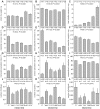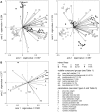Differential performance and parasitism of caterpillars on maize inbred lines with distinctly different herbivore-induced volatile emissions
- PMID: 23112820
- PMCID: PMC3480431
- DOI: 10.1371/journal.pone.0047589
Differential performance and parasitism of caterpillars on maize inbred lines with distinctly different herbivore-induced volatile emissions
Abstract
Plant volatiles induced by insect feeding are known to attract natural enemies of the herbivores. Six maize inbred lines that showed distinctly different patterns of volatile emission in laboratory assays were planted in randomized plots in the Central Mexican Highlands to test their ability to recruit parasitic wasps under field conditions. The plants were artificially infested with neonate larvae of the fall armyworm Spodoptera frugiperda, and two of its main endoparasitoids, Campoletis sonorensis and Cotesia marginiventris, were released in the plots. Volatiles were collected from equally treated reference plants in the neighbourhood of the experimental field. The cumulative amount of 36 quantified volatile compounds determined for each line was in good accordance with findings from the laboratory; there was an almost 15-fold difference in total emission between the two extreme lines. We found significant differences among the lines with respect to the numbers of armyworms recovered from the plants, their average weight gain and parasitism rates. Average weight of the caterpillars was negatively correlated with the average total amount of volatiles released by the six inbred lines. However, neither total volatile emission nor any specific single compound within the blend could explain the differential parasitism rates among the lines, with the possible exception of (E)-2-hexenal for Campoletis sonorensis and methyl salicylate for Cotesia marginiventris. Herbivore-induced plant volatiles and/or correlates thereof contribute to reducing insect damage of maize plants through direct plant defence and enhanced attraction of parasitoids, alleged indirect defence. The potential to exploit these volatiles for pest control deserves to be further evaluated.
Conflict of interest statement
Figures






Similar articles
-
Spodoptera frugiperda Caterpillars Suppress Herbivore-Induced Volatile Emissions in Maize.J Chem Ecol. 2020 Mar;46(3):344-360. doi: 10.1007/s10886-020-01153-x. Epub 2020 Jan 30. J Chem Ecol. 2020. PMID: 32002720
-
Fungal infection reduces herbivore-induced plant volatiles of maize but does not affect naïve parasitoids.J Chem Ecol. 2006 Sep;32(9):1897-909. doi: 10.1007/s10886-006-9147-3. Epub 2006 Aug 11. J Chem Ecol. 2006. PMID: 16902818
-
Attraction of Spodoptera frugiperda larvae to volatiles from herbivore-damaged maize seedlings.J Chem Ecol. 2006 Sep;32(9):1911-24. doi: 10.1007/s10886-006-9117-9. Epub 2006 Aug 11. J Chem Ecol. 2006. PMID: 16902828
-
Attraction of parasitic wasps by caterpillar-damaged plants.Novartis Found Symp. 1999;223:21-32; discussion 32-8. doi: 10.1002/9780470515679.ch3. Novartis Found Symp. 1999. PMID: 10549546 Review.
-
Biochemical basis of resistance toward maize insect pests of different feeding guild and their inter-guild interactions.Planta. 2025 May 7;261(6):129. doi: 10.1007/s00425-025-04697-y. Planta. 2025. PMID: 40332612 Review.
Cited by
-
Chemical Ecology of the host searching behavior in an Egg Parasitoid: are Common Chemical Cues exploited to locate hosts in Taxonomically Distant Plant Species?J Chem Ecol. 2022 Aug;48(7-8):650-659. doi: 10.1007/s10886-022-01373-3. Epub 2022 Aug 3. J Chem Ecol. 2022. PMID: 35921017
-
Variation in plant responsiveness to defense elicitors caused by genotype and environment.Front Plant Sci. 2014 Jul 21;5:349. doi: 10.3389/fpls.2014.00349. eCollection 2014. Front Plant Sci. 2014. PMID: 25101103 Free PMC article. No abstract available.
-
The prospect of applying chemical elicitors and plant strengtheners to enhance the biological control of crop pests.Philos Trans R Soc Lond B Biol Sci. 2014 Feb 17;369(1639):20120283. doi: 10.1098/rstb.2012.0283. Print 2014 Apr 5. Philos Trans R Soc Lond B Biol Sci. 2014. PMID: 24535390 Free PMC article.
-
Insect attraction to herbivore-induced beech volatiles under different forest management regimes.Oecologia. 2014 Oct;176(2):569-80. doi: 10.1007/s00442-014-3025-4. Epub 2014 Jul 31. Oecologia. 2014. PMID: 25080178
-
Contrasting insect attraction and herbivore-induced plant volatile production in maize.Planta. 2018 Jul;248(1):105-116. doi: 10.1007/s00425-018-2886-x. Epub 2018 Apr 3. Planta. 2018. PMID: 29616394
References
-
- Dicke M, Baldwin IT (2010) The evolutionary context for herbivore-induced plant volatiles: beyond the ‘cry for help’. Trends Plant Sci 15: 167–175. - PubMed
-
- Turlings TCJ, Wäckers F (2004) Recruitment of predators and parasitoids by herbivore-injured plants. In: Cardé RT, Millar JG, editors. Advances in Insect Chemical Ecology: Cambridge University Press.
-
- Kessler A, Baldwin IT (2001) Defensive function of herbivore-induced plant volatile emissions in nature. Science 291: 2141–2144. - PubMed
-
- De Moraes CM, Lewis WJ, Paré PW, Alborn HT, Tumlinson JH (1998) Herbivore-infested plants selectively attract parasitoids. Nature 393: 570–573.
-
- Thaler JS (1999) Jasmonate-inducible plant defences cause increased parasitism of herbivores. Nature 399: 686–688.
Publication types
MeSH terms
LinkOut - more resources
Full Text Sources

